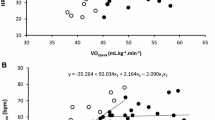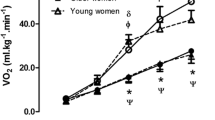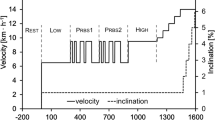Abstract
Peak exercise parameters are considered the gold standard to quantify cardiac reserve in cardiopulmonary exercise testing (CPET). We studied whether submaximal parameters would add additional values in analyzing sex differences in CPET. We reviewed CPET of age-matched healthy male and female adolescents by cycle ergometer. Besides peak parameters, submaximal CPET parameters, including ventilatory anaerobic threshold (VAT), oxygen uptake efficiency slope (OUES), and submaximal slopes of Δoxygen consumption (ΔVO2)/Δwork rate (ΔWR), Δheart rate (ΔHR)/ΔWR, ΔVO2/ΔHR, and Δminute ventilation (ΔVE)/ΔCO2 production (ΔVCO2), were obtained. We studied 35 male and 40 female healthy adolescents. Peak VO2 (pVO2), peak oxygen pulse (pOP), and VAT were significantly lower in females than males (1.9 ± 0.4 vs. 2.5 ± 0.6 L/min; 10 ± 2.0 vs. 13.2 ± 3.5 ml/beat; 1.23 ± 0.3 vs. 1.52 ± 0.5 L/min, respectively, all p < 0.005). Females showed significantly lower pVO2, VAT, and OUES with the same body weight than males, implying higher skeletal muscle mass in males. When simultaneously examining ΔHR/ΔWR and pOP, females showed higher dependency on increases in HR than in stroke volume. Females demonstrated significantly lower pOP with the same levels of ΔVO2/ΔHR, suggesting more limited exercise persistence than males under an anaerobic condition at peak exercise. Oxygen uptake efficiency in relation to peak VE was significantly higher in males. There was no sex difference in either ΔVO2/ΔWR or ΔVE/ΔVCO2. Combinational assessment of peak and submaximal CPET parameters delineates the multiple mechanisms that contribute to the sex differences in exercise performance.




Similar content being viewed by others
Abbreviations
- BMI:
-
Body mass index
- CPET:
-
Cardiopulmonary exercise testing
- OP:
-
Oxygen pulse
- OUES:
-
Oxygen uptake efficiency slope
- RAMP:
-
Raise, activate, mobilize, potentiate/performance
- VO2:
-
Oxygen consumption
- VCO2:
-
Carbon dioxide production
- VAT:
-
Ventilatory anaerobic threshold
- VE:
-
Minute ventilation
- WR:
-
Work rate
References
Albouaini K, Egred M, Alahmar A, Wright DJ (2007) Cardiopulmonary exercise testing and its application. Postgrad Med J 83:675–682
Mezzani A (2017) Cardiopulmonary exercise testing: basics of methodology and measurements. Ann Am Thorac Soc 14:S3–S11
Takken T, Blank AC, Hulzebos EH, Van Brussel M, Groen WG, Helders PJ (2009) Cardiopulmonary exercise testing in congenital heart disease: equipment and test protocols. Neth Heart J 17:339–344
Cooper DM, Leu S-Y, Galassetti P, Radom-Aizik S (2014) Dynamic interactions of gas exchange, body mass, and progressive exercise in children. Med Sci Sports Exerc 46:877–886
Cooper DM, Leu SY, Taylor-Lucas C, Lu K, Galassetti P, Radom-Aizik S (2016) Cardiopulmonary exercise testing in children and adolescents with high body mass index. Pediatr Exerc Sci 28:98–108
Herdy AH, Ritt LE, Stein R, Araujo CG, Milani M, Meneghelo RS, Ferraz AS, Hossri C, Almeida AE, Fernandes-Silva MM, Serra SM (2016) Cardiopulmonary exercise test: background, applicability and interpretation. Arq Bras Cardiol 107:467–481
Ten Harkel A, Takken T (2011) Normal values for cardiopulmonary exercise testing in children. Eur J Cardiovasc Prev Rehabil 18:676–677
Drinkwater BL (1973) Physiological responses of women to exercise. Exerc Sport Sci Rev 1:125–153
Rowland T, Goff D, Martel L, Ferrone L (2000) Influence of cardiac functional capacity on gender differences in maximal oxygen uptake in children. Chest 117:629–635
Ansdell P, Thomas K, Hicks KM, Hunter SK, Howatson G, Goodall S (2020) Physiological sex differences affect the integrative response to exercise: acute and chronic implications. Exp Physiol 105:2007–2021
Wheatley CM, Snyder EM, Johnson BD, Olson TP (2014) Sex differences in cardiovascular function during submaximal exercise in humans. Springerplus 3:445
Armstrong N, Welsman JR (1994) Assessment and interpretation of aerobic fitness in children and adolescents. Exerc Sport Sci Rev 22:435–476
Baba R, Masami N, Masahiko G, Yoshiko N, Mitsuhiro Y, Nobuo T, Kenji N (1996) Oxygen uptake efficieny slope: a new index of cardiorespiratory functional reserve derived from the relation between oxygen uptake and minute ventilation during incremental exercise. JACC 28:1567–1572
Armstrong N, Welsman J (2019) Sex-specific longitudinal modeling of youth peak oxygen uptake. Pediatr Exerc Sci 31:204–212
Rowland TW (1990) Developmental aspects of physiological function relating to aerobic exercise in children. Sports Med 10:255–266
Haizlip KM, Harrison BC, Leinwand LA (2015) Sex-based differences in skeletal muscle kinetics and fiber-type composition. Physiology (Bethesda) 30:30–39
Sparling PB (1980) A meta-analysis of studies comparing maximal oxygen uptake in men and women. Res Q Exerc Sport 51:542–552
Fomin A, Ahlstrand M, Schill HG, Lund LH, Stahlberg M, Manouras A, Gabrielsen A (2012) Sex differences in response to maximal exercise stress test in trained adolescents. BMC Pediatr 12:127
Turley KR, Wilmore JH (1997) Cardiovascular responses to submaximal exercise in 7- to 9-yr-old boys and girls. Med Sci Sports Exerc 29:824–832
Hossack KF, Bruce RA (1982) Maximal cardiac function in sedentary normal men and women: comparison of age-related changes. J Appl Physiol Respir Environ Exerc Physiol 53:799–804
Wilmore JHC, David L, Kenney WL (2008) Sex Differences in sport and exercise. Physiology of sport and exercise. Human Kinetics Publishers, Champaign, pp 422–446
Bar-Yoseph R, Porszasz J, Radom-Aizik S, Lu KD, Stehli A, Law P, Cooper DM (2019) The effect of test modality on dynamic exercise biomarkers in children, adolescents, and young adults. Physiol Rep 7:e14178
Handelsman DJ, Hirschberg AL, Bermon S (2018) Circulating testosterone as the hormonal basis of sex differences in athletic performance. Endocr Rev 39:803–829
Tarnopolsky LJ, MacDougall JD, Atkinson SA, Tarnopolsky MA, Sutton JR (1990) Gender differences in substrate for endurance exercise. J Appl Physiol (1985) 68:302–308
Dominelli PB, Molgat-Seon Y, Sheel AW (2019) Sex differences in the pulmonary system influence the integrative response to exercise. Exerc Sport Sci Rev 47:142–150
Sheel AW, Richards JC, Foster GE, Guenette JA (2004) Sex differences in respiratory exercise physiology. Sports Med 34:567–579
McClaran SR, Harms CA, Pegelow DF, Dempsey JA (1998) Smaller lungs in women affect exercise hyperpnea. J Appl Physiol (1985) 84:1872–1881
Masuki S, Eisenach JH, Schrage WG, Johnson CP, Dietz NM, Wilkins BW, Sandroni P, Low PA, Joyner MJ (2007) Reduced stroke volume during exercise in postural tachycardia syndrome. J Appl Physiol (1985) 103:1128–1135
Claessen G, La Gerche A, Van De Bruaene A, Claeys M, Willems R, Dymarkowski S, Bogaert J, Claus P, Budts W, Heidbuchel H, Gewillig M (2019) Heart rate reserve in fontan patients: chronotropic incompetence or hemodynamic limitation? J Am Heart Assoc 8:e012008
Acknowledgements
Authors thank Ms. Kimberley Eissmann and Ms. Michelle Stofa for editing this manuscript.
Funding
Authors declare no financial or non-financial interests that are directly or indirectly related to the work submitted for publication.
Author information
Authors and Affiliations
Corresponding author
Ethics declarations
Conflict of interest
No conflict of interest.
Additional information
Publisher's Note
Springer Nature remains neutral with regard to jurisdictional claims in published maps and institutional affiliations.
Supplementary Information
Below is the link to the electronic supplementary material.
246_2022_2832_MOESM1_ESM.pptx
Supplementary file1 (PPTX 58 kb). Supplemental Figure 1 Submaximal slope parameters of CPET in 9-year-old male. ΔVO2/ΔWR (exercise efficiency), ΔHR/ΔWR (heart rate dependency), ΔVO2*/ΔHR (stroke volume indexed by weight), OUES (oxygen uptake efficiency slope), and ΔVE/ΔVCO2 (ventilatory efficiency). An excellent correlation was seen in each graph
Rights and permissions
About this article
Cite this article
Kernizan, D., Glass, A., D’Aloisio, G. et al. A Combined Analysis of Peak and Submaximal Exercise Parameters in Delineating Underlying Mechanisms of Sex Differences in Healthy Adolescents. Pediatr Cardiol 43, 1122–1130 (2022). https://doi.org/10.1007/s00246-022-02832-0
Accepted:
Published:
Issue Date:
DOI: https://doi.org/10.1007/s00246-022-02832-0




